Stan C. Smith's Blog, page 21
June 16, 2022
Awesome Animal Fact - Poisonous Pufferfish
Did you know pufferfish, although extremely cute, are also extremely poisonous? Pufferfish, as well as several related fish, contain tetrodotoxin, one of the most toxic poisons found in nature, 1,200 times more toxic than cyanide. One pufferfish can contain enough of this toxin to kill 30 adult humans.
In case you aren't familiar with pufferfish, they are those cute, pudgy fish that blow up like a water balloon when threatened. Their shape makes them rather sluggish swimmers, so they are vulnerable to predators. At least they would be if it weren't for their inflatable ability and the tetrodotoxin in their bodies. If a predator grabs a pufferfish, the pufferfish will inflate and become difficult or even impossible to swallow. If the predator manages to grab the pufferfish before it inflates, the predator will probably soon regret its mistake when the toxin kicks in. Not only does the toxin taste really bad, it is deadly to other fish. So, if you think about it, when the pufferfish inflates and becomes impossible to swallow, it not only saves its own life, it also saves the predator's life.
Surprisingly, pufferfish meat is a very expensive delicacy in Japan, where the meat is called fugu. It is only prepared in certain restaurants by trained and certified chefs, who understand that making one wrong cut on the fish could be deadly to their customers.
In spite of this, more than 100 people die each year from eating improperly prepared pufferfish. In many restaurants, the sushi chefs are required to taste the fugu they have prepared before serving it to customers.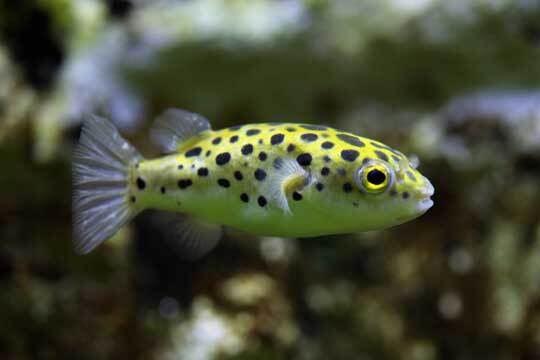
Photo Credits:
- Green-spotted pufferfish - DepositPhotos
In case you aren't familiar with pufferfish, they are those cute, pudgy fish that blow up like a water balloon when threatened. Their shape makes them rather sluggish swimmers, so they are vulnerable to predators. At least they would be if it weren't for their inflatable ability and the tetrodotoxin in their bodies. If a predator grabs a pufferfish, the pufferfish will inflate and become difficult or even impossible to swallow. If the predator manages to grab the pufferfish before it inflates, the predator will probably soon regret its mistake when the toxin kicks in. Not only does the toxin taste really bad, it is deadly to other fish. So, if you think about it, when the pufferfish inflates and becomes impossible to swallow, it not only saves its own life, it also saves the predator's life.
Surprisingly, pufferfish meat is a very expensive delicacy in Japan, where the meat is called fugu. It is only prepared in certain restaurants by trained and certified chefs, who understand that making one wrong cut on the fish could be deadly to their customers.
In spite of this, more than 100 people die each year from eating improperly prepared pufferfish. In many restaurants, the sushi chefs are required to taste the fugu they have prepared before serving it to customers.

Photo Credits:
- Green-spotted pufferfish - DepositPhotos
Published on June 16, 2022 09:12
June 12, 2022
Awesome Animal Fact - Loud Water Boatmen
Awesome Animal Fact:
Did you know the loudest animal, for its size, is the water boatman? One particular species of water boatman (Micronecta scholtzi), only about the size of a grain of rice, at 2 mm long, is capable of making the loudest sound relative to body size.
Scientists measured the volume of the water boatman's "song," even though the insect only sings underwater. They determined that these rowdy little critters can sing at 105 decibels, which is about as loud as a jackhammer pounding the concrete right next to you. A person can hear this sound standing at the edge of a pond where a boatman is singing at the bottom of the pond. The sound is produced below water, but most of the volume is lost when the sound crosses from water to air. This is probably a good thing for those of us who like the peacefulness of nature.
In case you're wondering how they make this sound, the male water boatman, in its attempts to attract females, rubs its penis against its abdomen. Kind of like how crickets make a ruckus by rubbing their wings together, except the water boatman uses its male sex organ instead. Will wonders never cease?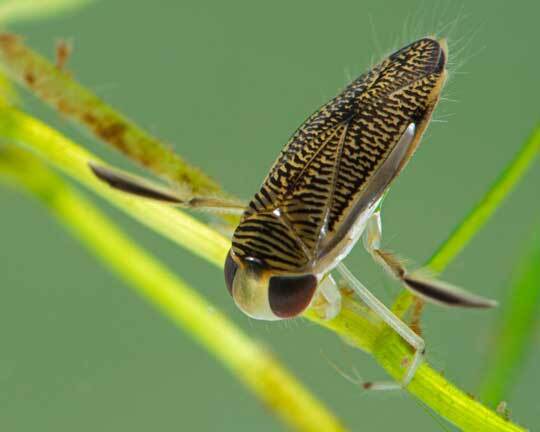 Photo Credits:
Photo Credits:
- Water boatman - DepositPhotos
Did you know the loudest animal, for its size, is the water boatman? One particular species of water boatman (Micronecta scholtzi), only about the size of a grain of rice, at 2 mm long, is capable of making the loudest sound relative to body size.
Scientists measured the volume of the water boatman's "song," even though the insect only sings underwater. They determined that these rowdy little critters can sing at 105 decibels, which is about as loud as a jackhammer pounding the concrete right next to you. A person can hear this sound standing at the edge of a pond where a boatman is singing at the bottom of the pond. The sound is produced below water, but most of the volume is lost when the sound crosses from water to air. This is probably a good thing for those of us who like the peacefulness of nature.
In case you're wondering how they make this sound, the male water boatman, in its attempts to attract females, rubs its penis against its abdomen. Kind of like how crickets make a ruckus by rubbing their wings together, except the water boatman uses its male sex organ instead. Will wonders never cease?
 Photo Credits:
Photo Credits:- Water boatman - DepositPhotos
Published on June 12, 2022 18:04
June 7, 2022
Awesome Animal - Pregnant Male Seahorses
Awesome Animal Fact:
Did you know baby seahorses develop inside the body of the adult male seahorse instead of the adult female? Seahorses (as well as the related pipe fishes and sea dragons) are the only known animals in which the males give birth to the young.
How does this work, you ask? Here's the process. It starts with an elaborate courtship "dance" that sometimes lasts hours or even days. Generally, such courtship behaviors accomplish two things: to make sure the desired mate is the same species (this is the reason species that look similar have different courtship displays), and to determine if the prospective mate is a worthy mate.
Once the courtship dance has served its purpose, the female seahorse deposits her eggs into the male's brood pouch. He then fertilizes the eggs inside his brood pouch. As the embryos grow, the male's abdomen becomes distended, just like a human female's abdomen during pregnancy.
When it's time for birth, the male's abdomen opens, and contractions squirt the babies out into the water. Male seahorses give birth to as many as 1,000 babies at a time. Why so many? Because life in the sea is harsh, and few of the babies survive to become adults.
We don't know for sure why seahorses have this reversal of gender roles, although one explanation is that this frees up the female to almost immediately form a new brood of eggs for another male, thus increasing her reproductive output.
Below is a male seahorse popping out the first of many babies.
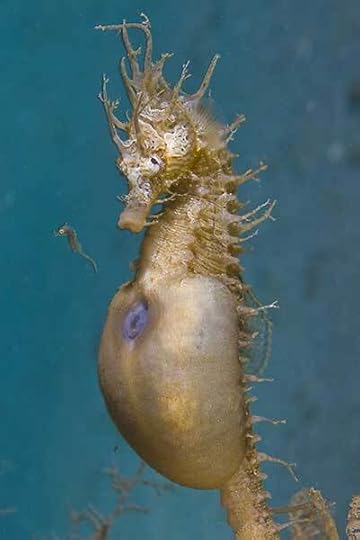
Photo Credits:
- Male seahorse giving birth - "seahorse baby" by jidanchaomian is marked with CC BY-SA 2.0.
Did you know baby seahorses develop inside the body of the adult male seahorse instead of the adult female? Seahorses (as well as the related pipe fishes and sea dragons) are the only known animals in which the males give birth to the young.
How does this work, you ask? Here's the process. It starts with an elaborate courtship "dance" that sometimes lasts hours or even days. Generally, such courtship behaviors accomplish two things: to make sure the desired mate is the same species (this is the reason species that look similar have different courtship displays), and to determine if the prospective mate is a worthy mate.
Once the courtship dance has served its purpose, the female seahorse deposits her eggs into the male's brood pouch. He then fertilizes the eggs inside his brood pouch. As the embryos grow, the male's abdomen becomes distended, just like a human female's abdomen during pregnancy.
When it's time for birth, the male's abdomen opens, and contractions squirt the babies out into the water. Male seahorses give birth to as many as 1,000 babies at a time. Why so many? Because life in the sea is harsh, and few of the babies survive to become adults.
We don't know for sure why seahorses have this reversal of gender roles, although one explanation is that this frees up the female to almost immediately form a new brood of eggs for another male, thus increasing her reproductive output.
Below is a male seahorse popping out the first of many babies.

Photo Credits:
- Male seahorse giving birth - "seahorse baby" by jidanchaomian is marked with CC BY-SA 2.0.
Published on June 07, 2022 14:53
June 3, 2022
Awesome Animal Fact - Noisy Oilbirds
Awesome Animal Fact:
Did you know the oilbird is the loudest of all the birds?
You probably wouldn't want to be in a cave when a group of oilbirds fly into the cave to roost. Oilbirds, like bats, use echolocation to find their way around in caves that are totally dark. Bats, however, use a call that is outside the human range of hearing. But oilbirds? Nope, not so much. Oilbird echolocation calls are perfectly audible to humans, and at close range can be up to 100 decibels. Try to imagine a whole swarm of them flying about in a cave all at once. Some colonies include thousands of birds!
Why are oilbirds so loud? Well, as I said, bats use echolocation to navigate in caves and to catch their insect prey outside of caves. Oilbirds, on the other hand, only use echolocation to navigate caves, not to catch their insect prey. This is probably because their echolocation sensitivity is relatively low—they aren't very good at it. In fact, scientists have found that they fly headfirst into plastic discs that are 4 inches (10 cm) in diameter, but they are able to avoid discs that are 8 inches (20 cm) in diameter. If they can't avoid a 4-inch disc, they definitely can't use echolocation to catch insects that are much smaller than 4 inches. Bats, on the other hand, can echolocate the tiniest of flying bugs. So, perhaps oilbirds have such loud calls to make their poor echolocation work at least well enough to avoid smacking into the walls of their cave.
Below are oilbirds clinging to the wall of their roosting cave.
 Photo Credits:
Photo Credits:
- Oilbirds on cave ceiling - DepositPhotos
Did you know the oilbird is the loudest of all the birds?
You probably wouldn't want to be in a cave when a group of oilbirds fly into the cave to roost. Oilbirds, like bats, use echolocation to find their way around in caves that are totally dark. Bats, however, use a call that is outside the human range of hearing. But oilbirds? Nope, not so much. Oilbird echolocation calls are perfectly audible to humans, and at close range can be up to 100 decibels. Try to imagine a whole swarm of them flying about in a cave all at once. Some colonies include thousands of birds!
Why are oilbirds so loud? Well, as I said, bats use echolocation to navigate in caves and to catch their insect prey outside of caves. Oilbirds, on the other hand, only use echolocation to navigate caves, not to catch their insect prey. This is probably because their echolocation sensitivity is relatively low—they aren't very good at it. In fact, scientists have found that they fly headfirst into plastic discs that are 4 inches (10 cm) in diameter, but they are able to avoid discs that are 8 inches (20 cm) in diameter. If they can't avoid a 4-inch disc, they definitely can't use echolocation to catch insects that are much smaller than 4 inches. Bats, on the other hand, can echolocate the tiniest of flying bugs. So, perhaps oilbirds have such loud calls to make their poor echolocation work at least well enough to avoid smacking into the walls of their cave.
Below are oilbirds clinging to the wall of their roosting cave.
 Photo Credits:
Photo Credits:- Oilbirds on cave ceiling - DepositPhotos
Published on June 03, 2022 07:05
June 2, 2022
Awesome Animal Fact - Brainy Octopuses
Did you know octopuses have three hearts and nine brains? (by the way, octopuses is the preferred plural, not octopi)
First let's consider the hearts. Octopuses have evolved this three-heart system as a result of living in deep areas of the ocean where oxygen is scarce. The three hearts help get oxygenated blood to all parts of the body. Two of the hearts pump blood to the gills, where the blood picks up dissolved oxygen. The third heart, the largest, pushes the oxygenated blood to all parts of the body, including the tips of those eight tentacles.
Okay, what about the nine brains? Octopuses have one centralized brain. Oddly, this brain is in the shape of a doughnut, and it is arranged around the esophagus. The food they eat actually passes through the hole in the brain (uh... food for thought?). This brain, like a human's brain, controls many of the overall body functions. But what about the other eight brains?
Have you ever watched an octopus move around? Those eight tentacles are constantly moving independently of each other, often with complex movements. What makes this possible is that each of the tentacles has its own brain, a complex bundle of nerves called a ganglia.
Here's an example of how that helps an octopus. Let's say the main brain tells the body to go check out a coral rock for a possible crab to eat. No problem. But then those eight arms start probing the coral, each of them reaching in a different crevice, feeling around for a snack. That requires a great deal of brain power, but the mini-brain in each tentacle allows the tentacle to act almost like an individual entity as it searches for food.
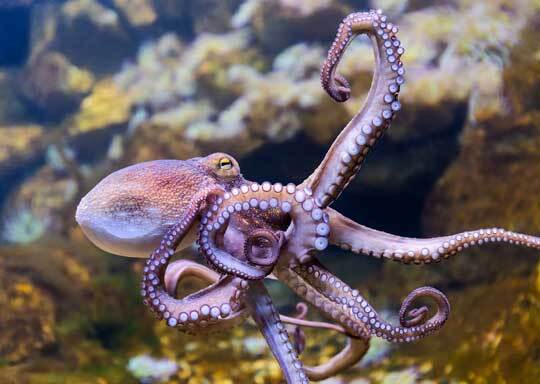 Photo Credits:
Photo Credits:
- Octopus - DepositPhotos
First let's consider the hearts. Octopuses have evolved this three-heart system as a result of living in deep areas of the ocean where oxygen is scarce. The three hearts help get oxygenated blood to all parts of the body. Two of the hearts pump blood to the gills, where the blood picks up dissolved oxygen. The third heart, the largest, pushes the oxygenated blood to all parts of the body, including the tips of those eight tentacles.
Okay, what about the nine brains? Octopuses have one centralized brain. Oddly, this brain is in the shape of a doughnut, and it is arranged around the esophagus. The food they eat actually passes through the hole in the brain (uh... food for thought?). This brain, like a human's brain, controls many of the overall body functions. But what about the other eight brains?
Have you ever watched an octopus move around? Those eight tentacles are constantly moving independently of each other, often with complex movements. What makes this possible is that each of the tentacles has its own brain, a complex bundle of nerves called a ganglia.
Here's an example of how that helps an octopus. Let's say the main brain tells the body to go check out a coral rock for a possible crab to eat. No problem. But then those eight arms start probing the coral, each of them reaching in a different crevice, feeling around for a snack. That requires a great deal of brain power, but the mini-brain in each tentacle allows the tentacle to act almost like an individual entity as it searches for food.
 Photo Credits:
Photo Credits:- Octopus - DepositPhotos
Published on June 02, 2022 20:07
May 25, 2022
Awesome Animal Fact - Old Greenland Sharks
Did you know there is a shark that can live more than 270 years? In my last email I featured a tortoise that was 190 years old, perhaps the oldest land animal. Well, the Greenland shark can live at least 272 years, and possibly 512 years or more.
I'll explain how we know this. Scientists have long guessed that Greenland sharks were old based simply on the fact that they grow only about 1 cm per year, and some are six meters long. But that's just guessing. Other types of sharks can be accurately aged by counting the growth rings on their vertebrae (or on the spines of their fins), but Greenland sharks don't have any hard tissue in their backbones, and they don't have fin spines. So, the ring-counting trick doesn't work.
Recently, though, scientists discovered certain proteins in the eyes of Greenland sharks that form before they are born and do not change throughout their entire lives. They found that they could age the sharks by carbon-dating these proteins. It's important to point out that they didn't catch and kill Greenland sharks specifically for this study. Instead, they used sharks that were accidentally caught in fishermen's nets.
Anyway, one of the sharks they looked at was 5 meters long. Its eye proteins were carbon-dated to be between 272 and 512 years old (carbon dating gives you a range rather than a specific age).
Why do Greenland sharks live so long? Mostly because they live in really cold water and have a really slow metabolism. Here's one more tidbit to blow your mind: Greenland sharks grow so slowly that biologists think they do not even become sexually mature until they are over a century old!
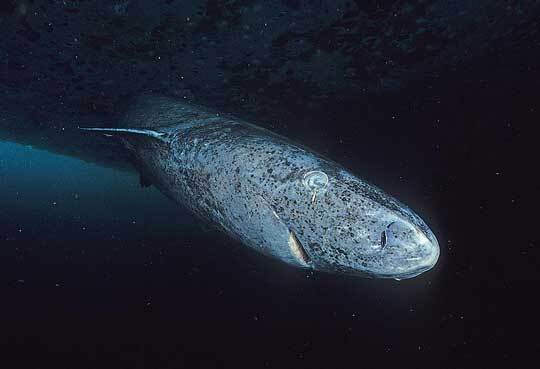
Photo Credits:
- Greenland shark - Hemming1952, CC BY-SA 4.0, via Wikimedia Commons
I'll explain how we know this. Scientists have long guessed that Greenland sharks were old based simply on the fact that they grow only about 1 cm per year, and some are six meters long. But that's just guessing. Other types of sharks can be accurately aged by counting the growth rings on their vertebrae (or on the spines of their fins), but Greenland sharks don't have any hard tissue in their backbones, and they don't have fin spines. So, the ring-counting trick doesn't work.
Recently, though, scientists discovered certain proteins in the eyes of Greenland sharks that form before they are born and do not change throughout their entire lives. They found that they could age the sharks by carbon-dating these proteins. It's important to point out that they didn't catch and kill Greenland sharks specifically for this study. Instead, they used sharks that were accidentally caught in fishermen's nets.
Anyway, one of the sharks they looked at was 5 meters long. Its eye proteins were carbon-dated to be between 272 and 512 years old (carbon dating gives you a range rather than a specific age).
Why do Greenland sharks live so long? Mostly because they live in really cold water and have a really slow metabolism. Here's one more tidbit to blow your mind: Greenland sharks grow so slowly that biologists think they do not even become sexually mature until they are over a century old!

Photo Credits:
- Greenland shark - Hemming1952, CC BY-SA 4.0, via Wikimedia Commons
Published on May 25, 2022 09:03
May 19, 2022
Awesome Animal Fact - Jumping Fleas
Did you know fleas are good jumpers? I don't mean so-so jumpers or pretty good jumpers, I mean really good jumpers. A variety of flea species have been studied for their jumping abilities (biologists are curious people, are they not?). One study looked at the jumping distance of 450 cat fleas (Ctenocephalides felis), and found that the average vertical jump is 5.2 inches (13 cm) and the average horizontal jump is 8 inches (20 cm). The very longest horizontal jump was 19 inches (48 cm).
This may not sound like much distance, but you need to consider that a cat flea is less than 3 mm long. Nineteen inches is essentially 160 time the flea's body length.
Okay, I'm about 5 foot 10 inches (177 cm) tall. If I could jump like the most athletic cat flea in that research study, I would hit the ground 933 feet from where I left the ground. That's longer than three football fields.
Not only can fleas jump far, they also jump incredibly fast. A flea completes its launch in less than one millisecond. This speed is much faster than would be possible with normal muscle movement. Instead of using their muscles to jump, they use their muscles to bend a part of their exoskeleton called the pleural arch. This acts as a spring, and when it releases, it throws the flea into the air with great force. Think of it like shooting a bow. Instead of using your muscles to throw the arrow, you use them to pull the bow string back.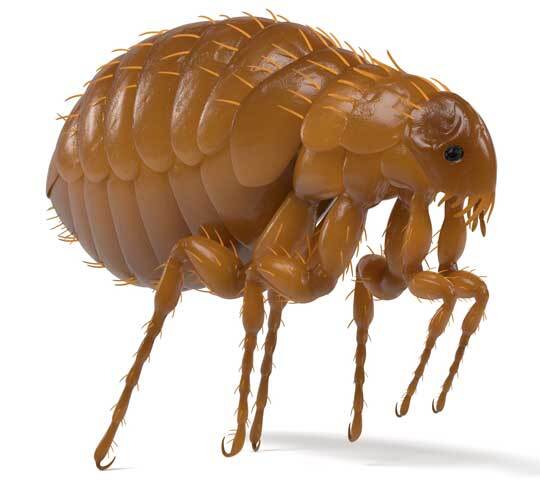
Photo Credits:
- 3D rendering of a flea - DepositPhotos
This may not sound like much distance, but you need to consider that a cat flea is less than 3 mm long. Nineteen inches is essentially 160 time the flea's body length.
Okay, I'm about 5 foot 10 inches (177 cm) tall. If I could jump like the most athletic cat flea in that research study, I would hit the ground 933 feet from where I left the ground. That's longer than three football fields.
Not only can fleas jump far, they also jump incredibly fast. A flea completes its launch in less than one millisecond. This speed is much faster than would be possible with normal muscle movement. Instead of using their muscles to jump, they use their muscles to bend a part of their exoskeleton called the pleural arch. This acts as a spring, and when it releases, it throws the flea into the air with great force. Think of it like shooting a bow. Instead of using your muscles to throw the arrow, you use them to pull the bow string back.

Photo Credits:
- 3D rendering of a flea - DepositPhotos
Published on May 19, 2022 05:24
May 14, 2022
Awesome Animal Fact - Chompy Crocodiles
Awesome Animal Fact:
Did you know the Nile crocodile has the strongest bite of all animals? Bite force is typically measured in pounds per square inch (psi). For perspective, the average bite force for a human is 162 psi. If you've ever had a little brother or sister, you know how much a human bite can hurt, am I right?
With the human bite force as our reference point, let's look at the bite forces of some of the animals with the most powerful jaws. For example, a hyena can bite at 1,100 psi. Youch! That is definitely bone-crunching power.
But the hyena isn't close to the most powerful. A polar bear? 1,200 psi. A gorilla? 1,300 psi (gorillas aren't predators, but they like to tear bark off of trees with their teeth). A jaguar? 1,500 psi (definitely a predator). A hippo? 1,800 psi (hippos are really good at defending themselves from those apex African predators). A saltwater crocodile? 3,700 psi. Seriously? 3,700 psi?
Finally, the champ, the Nile crocodile, at 5,000 psi. Those dudes like to crush their huge prey before swallowing them whole.
Wait! What about great white sharks? Don't they have pretty strong jaws? They do, but no one has been able to measure the force with a live specimen. Maybe they just aren't very cooperative study subjects? However, by using multiple x-ray images to create computer models of the skull of a great white, scientists have estimated the bite force to be about 4,000 psi, which would put the great white in second place.
Still, the Nile crocodile is the champ of chomp.

Photo Credits:
- Nile crocodile - DepositPhotos
Did you know the Nile crocodile has the strongest bite of all animals? Bite force is typically measured in pounds per square inch (psi). For perspective, the average bite force for a human is 162 psi. If you've ever had a little brother or sister, you know how much a human bite can hurt, am I right?
With the human bite force as our reference point, let's look at the bite forces of some of the animals with the most powerful jaws. For example, a hyena can bite at 1,100 psi. Youch! That is definitely bone-crunching power.
But the hyena isn't close to the most powerful. A polar bear? 1,200 psi. A gorilla? 1,300 psi (gorillas aren't predators, but they like to tear bark off of trees with their teeth). A jaguar? 1,500 psi (definitely a predator). A hippo? 1,800 psi (hippos are really good at defending themselves from those apex African predators). A saltwater crocodile? 3,700 psi. Seriously? 3,700 psi?
Finally, the champ, the Nile crocodile, at 5,000 psi. Those dudes like to crush their huge prey before swallowing them whole.
Wait! What about great white sharks? Don't they have pretty strong jaws? They do, but no one has been able to measure the force with a live specimen. Maybe they just aren't very cooperative study subjects? However, by using multiple x-ray images to create computer models of the skull of a great white, scientists have estimated the bite force to be about 4,000 psi, which would put the great white in second place.
Still, the Nile crocodile is the champ of chomp.

Photo Credits:
- Nile crocodile - DepositPhotos
Published on May 14, 2022 16:45
May 9, 2022
Awesome Animal Fact - Old Tortoise
Did you know there is a tortoise that is 190 years old? Jonathan the tortoise is estimated to have hatched in 1832. This estimate is based on a letter written in 1882, when Jonathan arrived on St. Helena, a remote island in the south Atlantic under British control. The tortoise was originally captured from the Seychelles Islands in the Indian Ocean. In the letter, Jonathan was described as "fully grown." When it comes to giant tortoises, "fully grown" generally means at least 50 years old. So, it's quite possible Jonathan is older than 190.
To this day, Jonathan is still wandering around on the grounds of the governor's residence on St. Helena.
Again, let's put this into perspective. Jonathan has lived on the Governor's lawn while 31 different St. Helena governors have come and gone. Jonathan was alive when Andrew Jackson was president of the US, and through the terms of the next 39 US presidents. The very first automobile, called the "Motorwagen," was patented in 1886 by Karl Benz. Jonathan was at least 54 years old then. January 1, 1983 is considered the official birthday of the Internet. Jonathan was at least 152 on that day.
Although there are aquatic animals that probably live longer (sharks, for example), Jonathan may be the oldest terrestrial animal alive today.
Jonathan is now losing his eyesight, but he has a dedicated veterinarian who feeds him by hand. In spite of his age, Jonathan still mates with the other tortoises living on the grounds of the governor's residence, including the one named Fred. Jonathan doesn't seem to care about minor details like gender.
The photo below was taken in 1886, four years after Jonathan arrived at the Governor's residence. Jonathan is the tortoise on the left.

Photo Credits:
- 1886 photo of Jonathan the tortoise - Unknown photographer, Public domain, via Wikimedia Commons
To this day, Jonathan is still wandering around on the grounds of the governor's residence on St. Helena.
Again, let's put this into perspective. Jonathan has lived on the Governor's lawn while 31 different St. Helena governors have come and gone. Jonathan was alive when Andrew Jackson was president of the US, and through the terms of the next 39 US presidents. The very first automobile, called the "Motorwagen," was patented in 1886 by Karl Benz. Jonathan was at least 54 years old then. January 1, 1983 is considered the official birthday of the Internet. Jonathan was at least 152 on that day.
Although there are aquatic animals that probably live longer (sharks, for example), Jonathan may be the oldest terrestrial animal alive today.
Jonathan is now losing his eyesight, but he has a dedicated veterinarian who feeds him by hand. In spite of his age, Jonathan still mates with the other tortoises living on the grounds of the governor's residence, including the one named Fred. Jonathan doesn't seem to care about minor details like gender.
The photo below was taken in 1886, four years after Jonathan arrived at the Governor's residence. Jonathan is the tortoise on the left.

Photo Credits:
- 1886 photo of Jonathan the tortoise - Unknown photographer, Public domain, via Wikimedia Commons
Published on May 09, 2022 06:27
May 8, 2022
Awesome Animal Fact - Big Blue Whales
Did you know blue whales are really big? You probably did know, but let's bring this into perspective. An adult blue whale's heart is the size of a Volkswagen Beetle... really. A heart the size of a car.
Blue whales grow to 100 feet (30.5 m) in length, and they weigh about 400,000 pounds (181,437 kilograms). Because I'm already measuring things in VW Beetles, this is the equivalent of 135 VW Beetles. Wait... that was measured in VW Beetles manufactured in 2003, which weigh about 2,900 pounds each. A 1960 VW Beetle weighs only 1,600 pounds. So, actually, if we want to use the 1960 Beetle as a unit of weight, a blue whale is equivalent to 250 VW Beetles. That sounds even more impressive.
Let's keep going with this. A blue whale's tongue (just the tongue), weighs 5,400 pounds (2,449 kg). Yep, a tongue with the mass of 3.3 VW Beetles (of the 1960 variety).
Finally, blue whales give birth to the largest babies of any living animals. Newborn babies are 26 feet (8 m) long and weigh 8,000 pounds (3,629 kg). So... (drumroll please) mother blue whales give birth to something that is the equivalent of FIVE Volkswagen Beetles.
We need a moment of silence to let that sink in.
Photo Credits:
- Computer-generated blue whale - DepositPhotos
Blue whales grow to 100 feet (30.5 m) in length, and they weigh about 400,000 pounds (181,437 kilograms). Because I'm already measuring things in VW Beetles, this is the equivalent of 135 VW Beetles. Wait... that was measured in VW Beetles manufactured in 2003, which weigh about 2,900 pounds each. A 1960 VW Beetle weighs only 1,600 pounds. So, actually, if we want to use the 1960 Beetle as a unit of weight, a blue whale is equivalent to 250 VW Beetles. That sounds even more impressive.
Let's keep going with this. A blue whale's tongue (just the tongue), weighs 5,400 pounds (2,449 kg). Yep, a tongue with the mass of 3.3 VW Beetles (of the 1960 variety).
Finally, blue whales give birth to the largest babies of any living animals. Newborn babies are 26 feet (8 m) long and weigh 8,000 pounds (3,629 kg). So... (drumroll please) mother blue whales give birth to something that is the equivalent of FIVE Volkswagen Beetles.
We need a moment of silence to let that sink in.

Photo Credits:
- Computer-generated blue whale - DepositPhotos
Published on May 08, 2022 16:25



